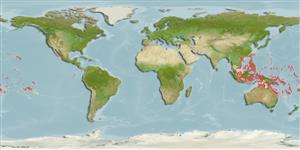Environment: milieu / climate zone / depth range / distribution range
Ekologi
marina revassocierade; djupintervall 8 - 31 m (Ref. 58302). Tropical; 26°N - 28°S
Pacific Ocean: Japan,Taiwan, Philippines, Moluccas, Fiji, Marshall Islands and Easter Island.
Size / Vikt / Age
Maturity: Lm ? range ? - ? cm
Max length : 8.0 cm SL hane/ej könsbestämd; (Ref. 48635)
Taggstrålar i ryggfenan (totalt): 3; Mjukstrålar i ryggfenan (totalt): 12-13; Mjukstrålar i analfenan: 7. Recognized by three white spots (Ref. 48635). Bony part of illicium approximately 1/2 length of 2nd dorsal spine; esca bulbous with 8-10 club-shaped tentacles.
Inhabit outer reef slopes (Ref. 1602). Benthic (Ref. 58302). Oviparous. Eggs are bound in ribbon-like sheath or mass of gelatinous mucus called 'egg raft' or 'veil' (Ref. 6773).
Life cycle and mating behavior
Könsmognad | Reproduktion | Lek | Ägg | Fecundity | Larver
Oviparous. Eggs are bound in ribbon-like sheath or mass of gelatinous mucus called 'egg raft' or 'veil' (Ref. 6773).
Pietsch, T.W. and D.B. Grobecker, 1987. Frogfishes of the world. Systematics, zoogeography, and behavioral ecology. Stanford University Press, Stanford, California. 420 p. (Ref. 6773)
IUCN Red List Status (Ref. 130435)
Threat to humans
Harmless
Human uses
Ytterligare information
referenserVattenbrukVattenbruksprofilAvelslinjerGenetikElectrophoresesÄrftlighetSjukdomarBehandlingNutrientsMass conversion
MedarbetareBilderStamps, Coins Misc.LjudCiguateraHastighetSimsättGälytaOtolithsHjärnstorlekSyn
Verktyg
Special reports
Download XML
Internet-källor
Estimates based on models
Preferred temperature (Ref.
123201): 24.6 - 28.8, mean 27.6 °C (based on 216 cells).
Phylogenetic diversity index (Ref.
82804): PD
50 = 0.5005 [Uniqueness, from 0.5 = low to 2.0 = high].
Bayesian length-weight: a=0.01995 (0.00906 - 0.04395), b=3.01 (2.83 - 3.19), in cm total length, based on all LWR estimates for this body shape (Ref.
93245).
Trofisk nivå (Ref.
69278): 3.8 ±0.7 se; based on size and trophs of closest relatives
Resiliens (Ref.
120179): Hög, lägsta populationsfördubblingstid mindre än 15 månader (Fec assumed to be > 10,000).
Fishing Vulnerability (Ref.
59153): Low vulnerability (10 of 100).
